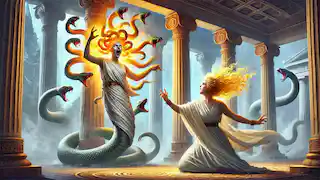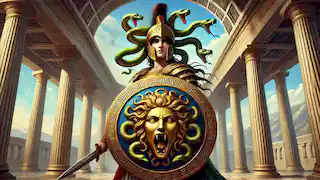In the heart of ancient Greece, where myths and legends wove into the very fabric of life, the tale of the Gorgon was both feared and revered. This story is one of tragedy, power, and mystery—a tale meant to caution against unchecked desire, wrath of the gods, and the peril of beauty. Passed down by the fireside and shared among generations, it became a symbol of both warning and wonder. Once upon a time, long before the heroes of Greece set foot upon their daring quests, three sisters were born on the farthest edge of the known world, near the River Oceanus. Stheno, Euryale, and Medusa were the children of ancient sea deities, Phorcys and Ceto, gods of the hidden dangers of the sea. These sisters, later to be known as the Gorgons, were unlike any others, for their beauty and charm were unparalleled. Stheno and Euryale were immortal, protected from death by the decree of the gods. Medusa, however, was not blessed with immortality; her fate was bound to the mortal coil, leaving her exposed to the whims of time and circumstance. The three sisters were loved by the gods for their grace and beauty, especially Medusa, who was said to have hair as golden as the sun and eyes as deep as the sea. Her beauty was both her blessing and her curse, for she became the envy of goddesses and the desire of gods alike. Stheno and Euryale, though equally beautiful, were fierce and proud, but Medusa held a certain softness in her heart—a purity that set her apart. She served as a priestess of Athena, goddess of wisdom and war, vowing her loyalty and purity to the deity she worshipped. Medusa’s fate took a cruel turn when Poseidon, god of the sea, was captivated by her beauty. One fateful day, he came to her within the sacred temple of Athena, drawn by an irresistible longing. Medusa, bound by her loyalty to Athena and her vows of chastity, resisted him. But Poseidon, unheeding of her pleas, forced himself upon her within the holy grounds of the goddess’s temple. This violation sent shockwaves through the realm of the gods, and Athena, enraged that her temple had been defiled, sought retribution—not upon Poseidon, but upon the helpless Medusa. The goddess appeared before Medusa, her eyes blazing with wrath. In a moment of divine fury, Athena cursed her, condemning her for the desecration of the temple. Medusa’s radiant hair transformed into writhing, venomous serpents, and her once-beautiful face became a visage of horror. Her eyes, which had once inspired love, would now invoke terror, turning anyone who gazed upon her into stone. With this curse, Athena banished Medusa to a remote island, where she would be doomed to live in solitude, feared and shunned by all. Medusa’s life became a harrowing existence as she tried to come to terms with her new form. She was no longer the beloved maiden of Athens, admired by gods and men alike. Instead, she was a monster, a creature feared by all who knew her name. Her sisters, Stheno and Euryale, upon hearing of their sister’s fate, were heartbroken. They abandoned their lives in the world and joined Medusa in her exile, becoming Gorgons themselves, forever united in their love and solidarity. The island of Medusa became a place of desolation, a wasteland littered with the statues of those who dared to approach her, adventurers and warriors who sought to end her life, only to be petrified by her deadly gaze. Medusa’s heart was broken, and with every passing day, she grew more sorrowful and angry. She remembered her life as a priestess and the love she had once felt from the gods, now replaced by fear and hatred. Years passed, and Medusa’s tale grew, whispered in hushed tones across the land. She became the embodiment of dread, a nightmare used to frighten children. Yet, she was also a prize for the brave—a challenge only the strongest could face. Among those who heard her tale was Perseus, the son of Zeus and Danaë, who was fated for greatness. King Polydectes of Seriphos, who sought the hand of Danaë, devised a plot to rid himself of Perseus, who opposed the union. Polydectes commanded Perseus to bring him the head of Medusa, believing it to be an impossible task. Perseus, though young and untried, was determined to fulfill the king’s command. Armed with gifts from the gods—a shield from Athena, a sword from Hephaestus, winged sandals from Hermes, and the helm of darkness from Hades—he set forth on his quest. Each gift would play a vital role in protecting him from Medusa’s deadly powers. As Perseus traveled to the distant island, he encountered the Graeae, three sisters who were ancient and wise, each sharing one eye and one tooth among them. Knowing they held knowledge of Medusa’s whereabouts, Perseus cleverly seized their shared eye, demanding guidance in exchange for its return. Reluctantly, the Graeae told him where to find Medusa. Upon arriving on the island, Perseus steeled himself, remembering Athena’s guidance to avoid looking directly at Medusa. Using the polished surface of his shield as a mirror, he carefully approached her lair. The once-beautiful Medusa, now a monstrous figure surrounded by serpents, was asleep. Her slumber was fitful, haunted by memories of her lost life and her curse. In a swift, calculated motion, Perseus brought down the sword of Hephaestus upon her neck, severing her head. The moment he struck, an eruption of powerful energies swept across the island, and from Medusa’s blood sprung two mythical beings: the winged horse Pegasus and the warrior Chrysaor. These were Medusa’s children, conceived in the tragic encounter with Poseidon, now born in her death. With Medusa’s head in hand, Perseus placed it in a magical sack, careful to avoid its deadly gaze. Even in death, her head retained its petrifying power, a force so feared that no mortal dared to look upon it. {{{_03}}} Returning to Seriphos, Perseus used Medusa’s head to rescue his mother, Danaë, and destroy Polydectes and his court, who had tormented her. The power of Medusa’s gaze became a weapon for justice, turning tyrants and wrongdoers to stone. Eventually, Perseus offered the head of Medusa to Athena, who placed it upon her shield, the Aegis, making it a symbol of her power and protection. Medusa’s legacy thus became one of duality—she was both a monster and a martyr, her face both terrifying and revered. Athena’s shield bore her likeness, a reminder of the price Medusa paid for beauty and the cruelty she suffered at the hands of gods. Though Medusa’s life had ended in tragedy, her story did not fade. Over the centuries, poets, artists, and philosophers came to view Medusa as a figure of great complexity. She was seen not merely as a monster, but as a victim of injustice—a woman wronged by the gods, punished for a crime she did not commit. She became a symbol of resilience, her tale serving as a poignant reminder of the cost of divine wrath and the peril of unchecked beauty. Even Athena, who had once cursed her, came to respect Medusa’s memory. By adorning her shield with the Gorgon’s head, Athena symbolized a kind of reconciliation, acknowledging Medusa’s suffering and honoring her as a protector against evil. Medusa’s image, once feared, became revered, a guardian against harm and a figure of strength. Today, the legend of Medusa endures, her face depicted in art and her story told as a cautionary tale. The image of the Gorgon reminds us of the thin line between beauty and danger, love and vengeance, victim and monster. Medusa’s tale resonates as both a warning and an inspiration, a powerful myth that echoes the complexities of human nature and the mysteries of fate. In every corner of Greece, from the grand temples of Athens to the humble homes of villagers, her story is shared in the hopes that future generations will remember the lessons it holds. Medusa, the Gorgon, lives on in memory—a symbol of beauty, tragedy, and ultimately, transformation.The Origins of the Gorgon Sisters

The Curse of Athena
The Transformation and Isolation

The Hero’s Quest
The Battle on the Island
The Power of Medusa’s Head
The Redemption of Medusa’s Name

Epilogue: Medusa’s Legacy in Greece
The Tale of the Gorgon
Reading Time: 7 min

About Story: The Tale of the Gorgon is a Myth Stories from greece set in the Ancient Stories. This Descriptive Stories tale explores themes of Redemption Stories and is suitable for All Ages Stories. It offers Moral Stories insights. A legendary ruler unites a nation and shapes a civilization.


















